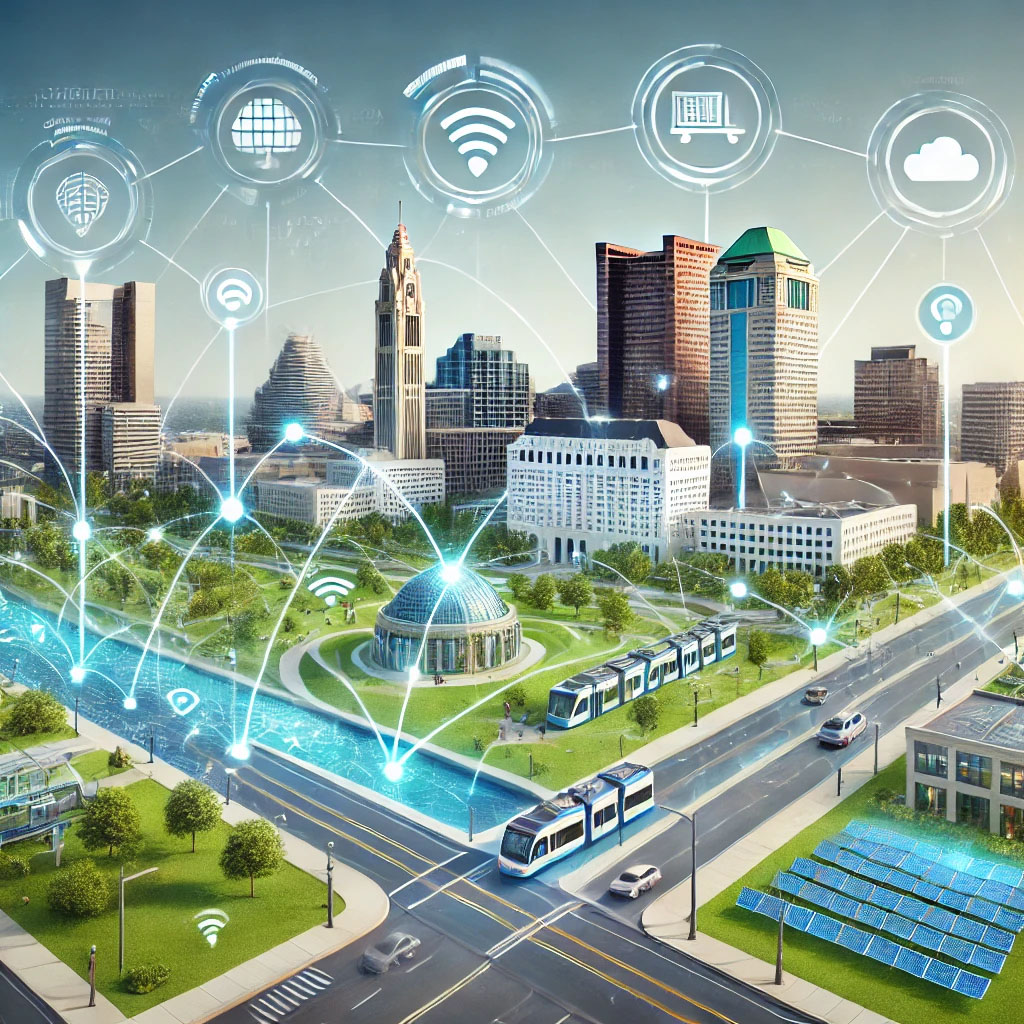High-speed internet is a crucial technology. Its implementation is understandably occurring worldwide to advance businesses, industry growth, and personal endeavors. Access to free, ubiquitous WiFi is a necessity for modern-day living and a certified way to propel communities into the future. Today, High-speed internet is no longer just an individual need but a way to eliminate community issues, revitalize education, and promote accessibility for city residents.
Columbus, Ohio, is emerging as a leader in the smart city movement thanks to its commitment to leveraging high-speed internet. The city’s vision includes creating an interconnected urban environment where technology and data improve public services, enhance sustainability, and drive economic opportunity. At the core of this robust vision is high-speed internet, which is the backbone for various technological initiatives like eco-friendly electrical grids, traffic improvement, air quality monitoring, and public safety.
Smart City Innovation
A smart city is similar to concepts like “smart home” or “smart device.” Simplistically, the term is defined as using automation, analytics, and AI to solve problems or enhance established technology.
Smart cities represent the forefront of urban innovation, using technology and data to enhance the quality of life for residents. A city powered by automation can improve sustainability, streamline metropolitan operations, and upgrade accessibility.
In the United States, cities like San Francisco, New York, and Chicago are pioneers in integrating smart technologies. These cities utilize interconnected devices and high-speed internet to track air quality, monitor traffic issues, and provide advanced services. Smart cities tend to focus on transportation, energy management, public safety, and environmental hazards to create a better quality of living for their residents.
High-Speed Internet in Columbus
Smart Energy Grids
Columbus’s slow transformation into a smart city hasn’t been an easy or quick change. But, one of the most significant areas of innovation in Columbus has been the development and investment in smart energy grids. These grids use sensors and data analytics to determine necessary distribution and reduce energy consumption. With real-time data, energy providers can manage supply more efficiently, reduce outages, and integrate renewable energy sources more effectively.
High-speed internet ensures that data from thousands of sensors across the city is transmitted quickly and reliably, enabling responsive and adaptive energy management.
Environmental Monitoring Systems
High-speed internet also supports advanced environmental monitoring systems in Columbus. These systems use a network of sensors to track air and water quality, noise levels, and weather conditions in real-time. Monitoring systems range from air quality and water sensors to weather stations that collect data on temperature and rainfall. Collected environmental data helps city officials identify pollution sources, monitor environmental changes, and implement measures to protect public health.
Here’s an example: on high pollution days, the city can alert residents, advising them to take precautions. Without these systems in place, citizens would not be notified promptly about possible hazards in the area. These monitoring technologies only work through reliable high-speed internet, which provides necessary information effectively and quickly.
Transportation and Mobility
Smart cities strongly focus on correcting transportation for better accessibility, improved road conditions, and fewer delays. Columbus is transforming its transportation infrastructure with the help of high-speed internet by building smart traffic management systems and self-driving shuttles. These systems use instantaneous data to control traffic lights, reducing congestion and improving traffic flow.
Additionally, Columbus is developing connected vehicle technology, where cars communicate with each other and traffic infrastructure to enhance safety and efficiency. The city received a $40 million grant from the US Department of Transportation to test and utilize this groundbreaking technology. High-speed internet enables the rapid data exchange necessary for these futuristic cars to receive messages regarding traffic congestion and potential road hazards.
Public Safety and Emergency Services
In the realm of public safety, high-speed internet is crucial for enhancing emergency response capabilities. Columbus has invested in smart surveillance systems that provide video feeds to law enforcement agencies. These systems help monitor high-risk areas and respond quickly to incidents.
Reliable, fast internet also supports advanced communication systems for emergency responders, ensuring they have the information they need when responding to crises. This connectivity is vital for coordinating efforts and improving emergency vehicle response times.
High-Speed Internet and Economic Growth
The deployment of high-speed internet in Columbus is driving smart city initiatives and fostering economic growth. Reliable and fast internet connectivity attracts businesses, particularly in the technology and innovation sectors.
In America, companies are more likely to invest in a city with advanced digital infrastructure. Since AI and automation have become increasingly popular in nationwide industries, entrepreneurs and business owners are more likely to involve themselves in an area that implements high-speed internet and modern technology. Free, public internet also enables remote workers and digital entrepreneurship, allowing residents to start and run businesses from home.
Columbus’s Future
While Columbus has made significant strides in becoming a smart city, there are challenges to overcome. Ensuring equitable access to high-speed internet for all residents is crucial to avoid a digital divide. The city is also looking to address cybersecurity concerns, as increased connectivity can make systems vulnerable to data breaches and bad actors. Additionally, ongoing investment in infrastructure and technology is necessary to maintain and expand smart city initiatives.
Looking into the future, Columbus aims to continue utilizing high-speed internet to innovate and improve urban living. The city plans to expand its smart transportation systems, enhance environmental monitoring, and develop new platforms for citizen engagement. By staying at the forefront of technology, Columbus is poised to become a model for other cities seeking to embrace the automation movement.
Columbus’s journey towards smart city status showcases the unlimited power of high-speed internet. From smart energy grids and environmental monitoring to enhanced public safety and increasing digital literacy, reliable internet connectivity drives innovation and education across the city. As Columbus continues to invest in its digital infrastructure, it sets an example for other cities aiming to harness technology for sustainable development and improved quality of life.
